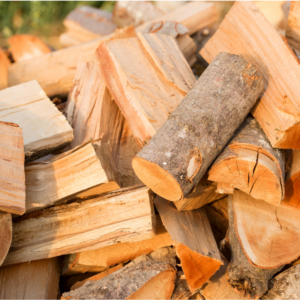It’s a matter of well-established fact that the only fuel you should be burning in your wood stove or fireplace is properly seasoned firewood. Not only does this keep your fires burning as cleanly and efficiently as possible, but burning anything else can be actually be hazardous to your home and flue.
You see the importance – but what exactly is seasoned firewood?
Seasoned Firewood: The Basics
 Simply put, seasoned firewood is wood that’s been dried out slowly until it reaches the optimal moisture range for burning.
Simply put, seasoned firewood is wood that’s been dried out slowly until it reaches the optimal moisture range for burning.
All living trees contain moisture, and when the tree is cut, its internal moisture content takes a while to evaporate out. Since fire and water don’t exactly mix, this evaporation process plays a key role in facilitating your relaxing evenings around the fireplace.
The exact length of time required to reach optimal moisture levels in your firewood varies depending on a number of factors, but if wood is stored out of direct contact of the elements, you can typically expect it to take around six months to a year to season.
What Influences Seasoning Time?
Factors that influence seasoning time include:
- the length and thickness of the cut wood
- whether it has been split to increase surface area and reduce overall size
- whether the wood is a hardwood or softwood variety
- how it’s stored
Wood should ultimately be cut with the size of your firebox in mind, but remember that shorter lengths and split logs mean less delay in seasoning. At the end of the day, there’s no rushing the process, so planning is key. When you cut wood, know that it’ll be prime for use next burn season. And once seasoned, you can expect firewood to last about three to four years.
How Can I Best Store My Firewood?
When storing firewood, you want to keep it from being in contact with precipitation that can cause dampness and decay – although really, it’s the internal moisture of the wood that’s being dried off during the seasoning process.
You’ll also want to store it off the ground. However, completely covering your woodpile isn’t necessary – as a matter of fact, you want to leave the sides of your wood pile exposed to circulating air and sunshine, which will encourage seasoning. Ensuring that the top of the wood pile is under cover and that banked snow or pounding rain isn’t consistently an issue affecting the sides of the pile should be sufficient.
How Can I Tell My Firewood Is Seasoned?
 How will you know when your wood is well-seasoned? There are some sensory clues that can indicate it’s ready. For instance, strike two pieces of wood together. Are your ears met with a dull thud or a hollow knock? The former tells you more time is needed, while the latter means you’re near the finish line. Visually, firewood should have visible cracking and the ends should be darkened. And wood should feel quite lightweight compared to when it was first cut.
How will you know when your wood is well-seasoned? There are some sensory clues that can indicate it’s ready. For instance, strike two pieces of wood together. Are your ears met with a dull thud or a hollow knock? The former tells you more time is needed, while the latter means you’re near the finish line. Visually, firewood should have visible cracking and the ends should be darkened. And wood should feel quite lightweight compared to when it was first cut.
If you still aren’t confident in the level of seasoning of your wood, a smart option is purchasing a moisture meter. This relatively inexpensive tool is readily available and will give you a quick readout on the moisture content of your firewood. The moisture level you’re looking for? Fifteen to twenty-five percent.
Once your wood is properly seasoned, it’s ready to use! Just keep in mind that you’ll want to rotate your firewood pile as new wood is added to keep the seasoned wood readily at hand – and the unseasoned wood out of the way while it seasons.
Why Happens If I Burn Unseasoned Wood?
While seasoning takes time and a little thought, it can’t be overlooked. Burning green or damp wood will require your fire to put a great deal of its energy into evaporating off moisture. This will lead to a smoky, sputtering flame that isn’t very satisfying to sit in front of – and is also inefficient.
Beyond that, the incomplete combustion that results from trying to burn firewood that isn’t seasoned can accelerate accumulation of soot and creosote in your chimney flue. Creosote is a dark, tarry, highly combustible, and hazardous substance that becomes increasingly difficult to remove over time. Clearly, you don’t want creosote building up in your chimney! Using only well-seasoned firewood will help keep buildup to a minimum.
Book Your Chimney Services With Us
Even when using the optimal fuel – well-seasoned firewood – don’t neglect your chimney care. Routine chimney sweepings will keep your chimney flue clear and help ensure its safe and efficient use. Annual inspections by an experienced chimney technician will give you expert eyes on your system from top to bottom, helping you identify any maintenance issues early – when they can likely be more simply and less expensively remedied than if left unseen to worsen.
If you have questions about chimney care, we’re here to serve you. We know the power of a beautiful, well-maintained wood stove or fireplace for warming a home and creating an inviting, homey ambiance. Whether you require masonry repairs, are exploring a fireplace facelift or upgrade, or simply need some routine maintenance, give us a call! We’re certified, experienced, and have a strong track record of excellent customer service.
Dial 570-221-4113 or book online today.

Recent Comments